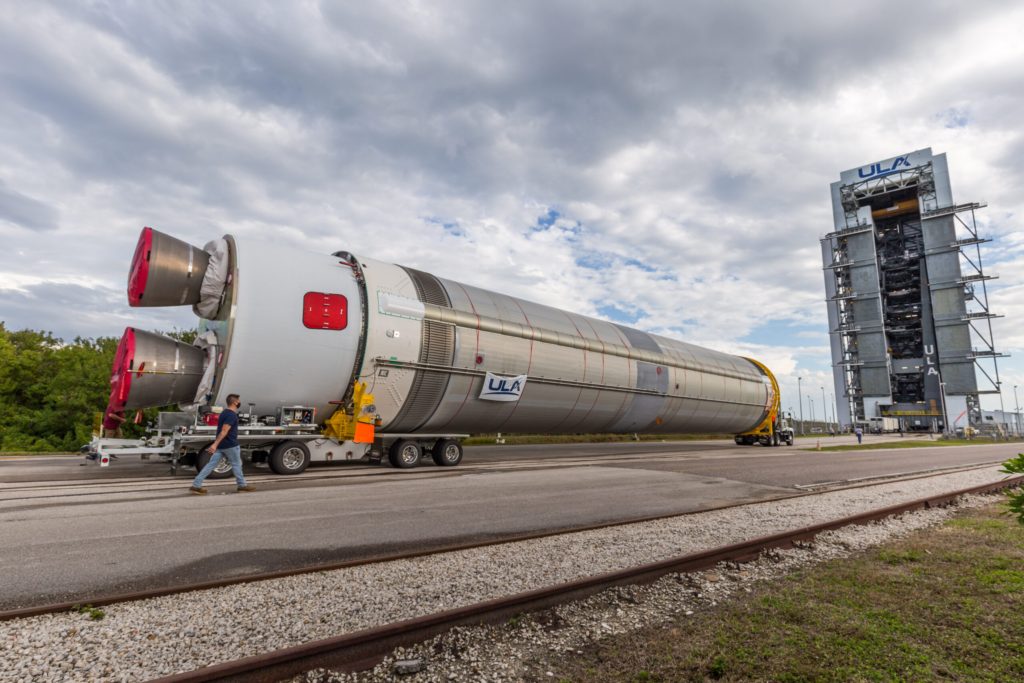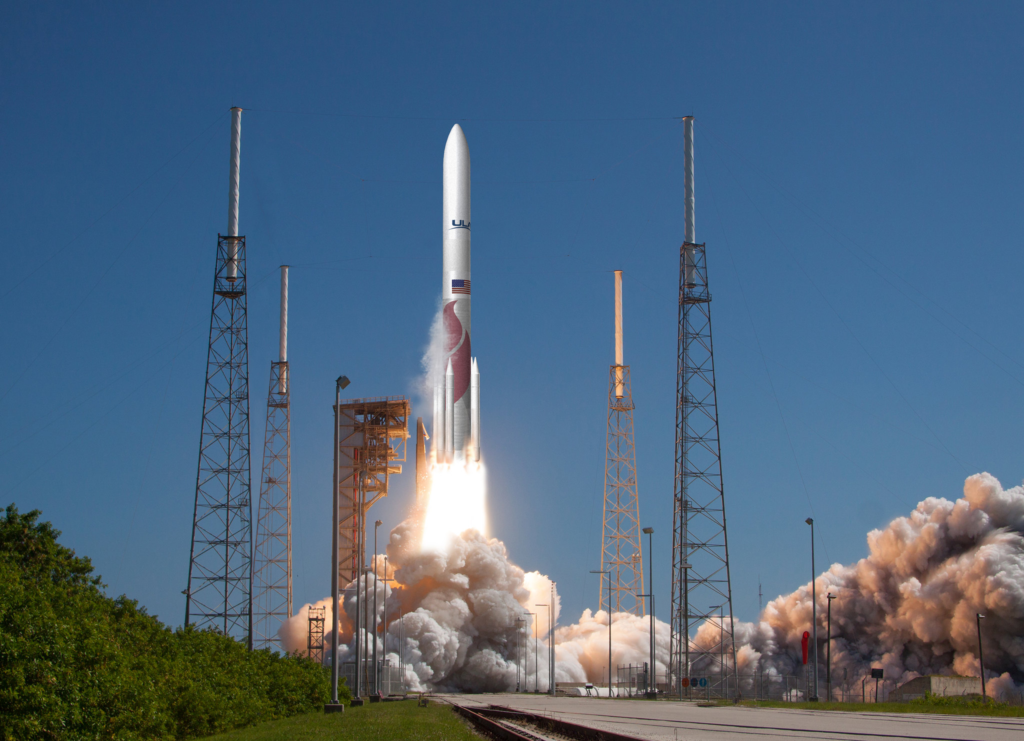
Vulcan Has Arrived At The Launch Site For Its Inaugural Flight
For close to a decade United Launch Alliance has been working on a next generation launch vehicle expected to become the company’s new workhorse. While currently not reusable, the Vulcan Centaur features an impressive payload capacity, new BE-4 engines, and plans for partial reuse technology in the future. The last few months have been very busy for this rocket as it prepares for its maiden flight only a month or two away.
After being shipped from ULA’s rocket factory in Decatur, the first and second stages have just arrived at the Cape via boat. With this journey complete, there are only a few final steps necessary before we see history be made. This includes a wet dress rehearsal and a flight readiness firing. If these tests show promising results, a launch as early as March is possible.
Another exciting part about this maiden flight has to do with the race for the first LOX/LNG rocket to fly. Other rockets such as Relativity’s Terran 1, and SpaceX’s Starship, are both on the pad and closing in on launches as well. Here I will go more in-depth into Vulcan’s launch site arrival, the exact tests needed prior to launch, whether or not the mission will be delayed, and more.
New Updates

Just over a week ago on January 13th, the Vulcan Centaur departed Decatur, Alabama for the voyage spanning more than 2,000 miles of rivers and the open sea to reach the Florida launch site. Yesterday Tory Bruno tweeted saying, “Ahoy there #VulcanRocket , welcome to Florida! #ULARocketShip, thank you for delivering the Vulcan Cert-1 rocket to its launch site!” In addition, only hours ago he tweeted again mentioning, “#Vulcan has arrived.” This included an image of the first stage being towed out of the ship and on its way to the facility.
On the 13th, the ship was loaded with the Vulcan hardware amid congratulatory celebrations marking the factory team’s successful completion of the first flight hardware, a moment coming after tireless dedication to build and test a new rocket that will reshape the launch industry landscape. RocketShip is a highly maneuverable, unique custom-built rocket transport ship with the versatility to navigate the shallow and deep waters along the route. The 312-foot (95-meter) -long roll-on, roll-off vessel has complete living quarters and dining area for its crew of 16, a below-deck machine shop, and sophisticated computers and navigational aids on the bridge. In total, this trip took about 8 days and featured no complications.
With Vulcan now at the Cape launch site, the rocket will undergo a final series of tests to verify its readiness for flight, consisting of multiple tanking tests and a wet dress rehearsal, culminating in flight readiness firing likey next month in February, which will be the final step prior to launch. Following the successful final testing, Astrobotic and the other payloads will be installed on the launch vehicle. Astrobotic is a company with the primary payload for this maiden flight. In the past, they have also caused some significant delays and forced the launch to be pushed back. However, one of the last updates we received from them was in November and stated that the team and payload were now ahead of schedule.
This being said, it’s important to point out that Vulcan’s delivery is later than expected. ULA said in a report only months ago that they expected Vulcan to arrive at the launch site in November and complete final testing in December. At this point, they are about two months behind and still targeting a first quarter launch. It’s possible that Vulcan is ready by March for lift off but a couple month delay is also realistic considering that this launch vehicle has never flown. A common theme for maiden flights are delays as different hardware including the BE-4 engines for example, and the rocket itself, have never actually launched. United Launch Alliance will also always favor taking more time to ensure the launch is a success rather than rushing a failure.
This commercial mission is part of ULA’s requirement to meet the U.S. Space Force certification of its new launch vehicle. Mark Peller, vice president of Major Development, stated “We are committed to ensuring we fly the first certification mission and stay on schedule to achieve U.S. Space Force certification of Vulcan in advance of our first national security space mission in 4th quarter 2023.” This combined with the payloads onboard makes it clear the importance of mission success.
Vulcan’s Future

Now that we know more about Vulcan’s delivery and upcoming final testing, we can take a closer look at the payloads onboard this launch and Vulcan’s busy future. Vulcan is meant to combine the best of today’s Atlas V and Delta IV Heavy rockets with the latest technology advancements to produce a single launch system that provides higher performance and greater affordability while continuing to deliver ULA’s reliability and precision. The single-core Vulcan can deliver payloads from low Earth orbit to Pluto and features a payload capacity to LEO ranging from 10,800kg to 27,200kg.
The new rocket can be built in less than half the time as its predecessors and launched at a much higher tempo. More than 70 Vulcan launches are currently on the manifest, including 38 launches to deploy a majority of Amazon’s Project Kuiper to provide fast, affordable broadband communities around the world; approximately 20 to 30 missions as the U.S. Space Force’s No. 1 offeror in the National Security Space Launch (NSSL) Phase 2 procurement; and the orbital delivery of Sierra Nevada Corp.’s Dream Chaser reusable spaceplane on cargo resupply missions to the International Space Station.
The upcoming inaugural mission, known as Certification-1, will deliver two Kuiper prototype broadband satellites into low Earth orbit, send the Astrobotic Peregrine commercial lunar lander to reach the Moon, and carry a Celestis Memorial Spaceflight Payload into deep space. Launching two prototype satellites on the first Vulcan mission “will give us practical experience working together ahead of those launches,” the vice president of technology for Project Kuiper, said in a news release. “Our prototype satellites will be ready this year, and we look forward to flying with ULA.” With so many future launch contracts related to this technology, an initial success is paramount for ULA and Vulcan,
The other important payload is the Perigrine lunar lander. Slated to be the first commercial lunar lander to ever soft land on the Moon, Peregrine is carrying payloads from NASA’s Commercial Lunar Payload Services initiative that was awarded in 2019. Similar to Vulcan, this payload has endured a lot of delays that are hoping to be avoided in these last few months.
With this in mind, we can focus back on Vulcan and its design. Starting at the bottom you have two brand new BE-4 engines ready for their first ever test flight. At sea level, these engines will provide 550,000 lbf at liftoff. In addition, Vulcan integrates up to six Northrop Grumman Graphite Epoxy Motor (GEM) 63XL Solid Rocket Boosters (SRBs). They are constructed out of a graphite-epoxy composite with the throttle profile designed into the propellant grain. GEM solids supported the Delta II and Delta IV rockets, and the GEM 63 variant has already flown on ULA’s Atlas V rocket. Beyond the first stage, Vulcan will rely on two RL10C engines to power its second stage. Logging an impressive record of nearly 400 successful flights and nearly 700 firings in space, RL10 engines, manufactured by Aerojet Rocketdyne, harness the power of high-energy liquid hydrogen. The RL10 boasts a precision control system and restart capability to accurately place payloads into orbit.
ULA has been heavily investing in modifying its factory in Decatur, Alabama, and modernizing its infrastructure at the launch facilities in Cape Canaveral, Florida, to support Vulcan rockets. Space Launch Complex-41 (SLC-41) will be the first dual-use pad launching both Atlas V and Vulcan rocket families. Specifically, Vulcan leverages existing infrastructure, including manufacturing and assembly at their sophisticated production facility in Decatur. ULA has invested heavily in the factory with new automated tooling solutions, welding equipment upgrades, robotic assembly lines for fabrication, and other upgrades for maximum efficiency.
At the very top, the payload fairing (PLF) provides a controlled, safe environment for spacecraft during ascent for the multiple payloads. All ULA PLFs are configured for off-pad payload encapsulation to enhance payload safety and security and minimize on-pad time. The spacecraft is encapsulated in a 5.4-m- (17.7-ft-) diameter payload fairing (PLF), a sandwich composite structure made with a vented aluminum-honeycomb core and graphite-epoxy face sheets. The payload fairing is available in the 15.5-m (51-ft) standard and 21.3-m (70-ft) long configurations. Something we will see in action in only months. “This has been an incredible journey to get to this point and I am so proud of the development team,” said Bruno. “We look forward to the first flight as Vulcan offers all customers higher performance and greater affordability while continuing to deliver our unmatched reliability.”
Conclusion
United Launch Alliance has had quite a few ups and downs with the Vulcan launch vehicle. Right now, the rocket has finally arrived at the Cape and is preparing for pre launch testing. This process includes a wet dress rehearsal and then a flight readiness firing. If everything looks good we can expect a launch as early as March. We will have to wait and see how it progresses and the impact it has on the space industry.
